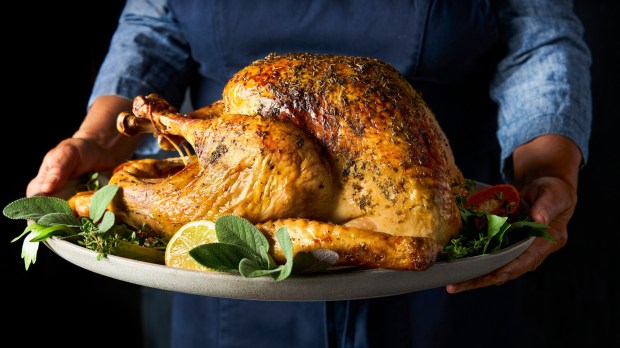Seoul’s Incheon Airport has taken a major stance. Throughout the terminal, large signs in Korean and English warn about an American product whose presence in your luggage can result int police action — Trader Joe’s Everything But the Bagel seasoning.
The seasoning blend — which includes poppyseeds, banned in South Korea for fear they will show up as positives on a drug test — is only sold in the United States. But products from Trader Joe’s have become so popular with international tourists that even a major Asian airport is getting involved.
Welcome to the cult of Trader Joe’s. Although it began in California as a health-food store, the brand has expanded across the US and now has travelers from around the world clamoring to visit one of its outlets.
Yes, you can go there to pick up a head of lettuce or a gallon of milk. But it’s equally likely a shopper heads to Trader Joe’s to try a fun snack like pickle-flavored popcorn, pumpkin spice protein bars, beer made with cookie butter (speculoos) or cheeseburger burritos.
So how did a place to stock up on produce manage to become a global sensation? Julie Averbach, author of The Art of Trader Joe’s, has a few theories.
“I think that Trader Joe’s is like the Disneyland of American grocery stores,” she says. “They’re appealing to customers’ different senses, everything from the eye-catching product packaging and the handmade artwork in the stores to the music on the speakers, the tasting counters for sampling products.”
Bite-size bytes
The first Trader Joe’s opened in Pasadena, part of Los Angeles county, in 1967. Yes, there really is a Joe — that would be Joe Coulombe, who was reportedly inspired by his global travels and wanted to make then-difficult-to-find ingredients more available in the US.
Today, there are more than 500 stores across the continental United States.
According to a 2024 study by Morning Consult, 25% of frequent Trader Joe’s shoppers belong to a household that makes over $100,000 annually. The research firm also describes them as “prolific social media users.”
That’s not surprising. People who live in the US — and those who don’t — often use social media to find out about the latest products.
But Trader Joe’s — TJ’s, to those in the know — fandom has become its own cottage industry, with TikTokers and YouTubers developing followings for regularly rating and reviewing new products or visiting different locations to see how they compare.
While some American chain stores rely on sameness to satisfy customers, Trader Joe’s has leaned in the other direction. Shops are encouraged to incorporate local iconography into their design — think a mural of the Space Needle in Seattle or a Lego model of the Golden Gate Bridge in San Francisco.
And it’s not only Trader Joe’s that has turned grocery shopping into a travel activity.
Travel booking website Expedia says that 39% of travelers usually visit a grocery store during their trips, and 44% make an effort to buy local goods — including food — they can’t get where they live.
More than a store
For Peruvian Maria Silva, who spent her college years in North Carolina and New York, Trader Joe’s became a crucial part of her American experience.
At first, she says, the store was a convenient place to get affordable staples like yogurt and fresh fruit. But she quickly started trying some of the more offbeat items, even bringing them home as family gifts at the holidays, getting her relatives hooked on TJ’s as well.
“I felt in terms of quality and price and the overall shopping experience it was my favorite (grocery store),” Silva says. “I like the packaging a lot, and also how the products are advertised in the store.” She counts the Panettone, vegetable samosas and chocolate-covered pretzels among her favorite items.
According to Averbach, all of this is intentional. The colorful, creative packaging — which is custom-made by on-staff graphic designers — makes many of their products “giftable.”
“They’re trying to dazzle and delight and to wow you,” says Averbach, “not just to sell you groceries.”
Even the product names are intended to be part of the brand. Mexican food products like salsa and tortillas are sold under the in-house “Trader Jose’s” label, while Chinese items like frozen dumplings are labeled as “Trader Ming’s.”
While some customers find the names cute, others disagree. In 2020, an online petition circulated calling the names racist and asking for them to be removed.
“We want to be clear: we disagree that any of these labels are racist. We do not make decisions based on petitions,” Trader Joe’s said in a statement at the time. “We thought then (when they were originally created) – and still do – that this naming of products could be fun and show appreciation for other cultures.”
Initially, the brand said it would remove some of the labels, only to backtrack soon after. Today, many of them remain on TJ’s shelves.
In addition to snack foods, the brand’s tote bags have become a phenomenon too. Different regions sell state- or city-themed totes, and a mini version of the bags went viral earlier this year, with resellers hawking them for as much as $500 on eBay.
Trader Joe’s told CNN that geography is crucial to their brand.
![]()
“Our product development team travels the world in search of products we think are exceptional and that we believe will find a following among our customers,” said a company representative in an email.
“To earn a spot on our shelves, each potential product is submitted to a rigorous tasting panel process. If a product is widely loved by the panel and represents an outstanding value, it earns its place on our shelves and becomes part of the Trader Joe’s shopping adventure.”
TJ’s is staying mum on whether they’ll ever open locations outside of the US. But as social media shows, they may not need to.
Scarcity can also lead to hyper-obsessed fandoms.
Although Silva has since left the US and moved to China, she still has a “wish list” for friends and colleagues who might be traveling to the US and have time to stop by a grocery store.
The-CNN-Wire™ & © 2024 Cable News Network, Inc., a Warner Bros. Discovery Company. All rights reserved.
Note: Thank you for visiting our website! We strive to keep you informed with the latest updates based on expected timelines, although please note that we are not affiliated with any official bodies. Our team is committed to ensuring accuracy and transparency in our reporting, verifying all information before publication. We aim to bring you reliable news, and if you have any questions or concerns about our content, feel free to reach out to us via email. We appreciate your trust and support!




